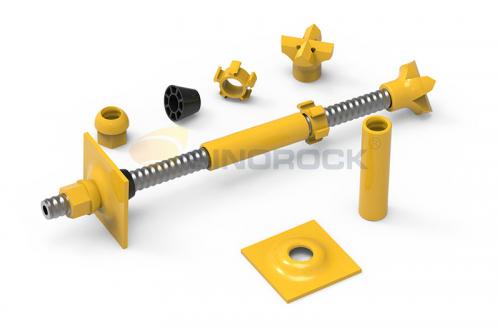Can Silty Clay Layer Be Supported by Self-drilling Hollow Rock Bolt?

As we all know, bolt support needs to adopt different support methods according to different geology. Silty clay belongs to cohesive soil, which is relatively hard when dry and relatively sticky when wet. Silty clay will absorb immediately when it comes into contact with water, so there are problems such as serious material consumption in bolt support. Below, Sinorock will answer the question of whether silty clay can be bolted for support. this question.
Difficulties of silty clay support
The soil is viscous
Silty clay is generally brownish-yellow, hard plastic, with small soil particles, low moisture content, and high-water absorption. In the support process, it is necessary to consider the difference between the actual pull-out force and the design pull-out force to see whether the tensile strength of the bolt can meet the pull-out force requirements.
Large pulp consumption
Since the silty clay has strong water absorption, and the soil will become viscous after absorbing water, in order for the bolt to be smoothly drilled into a hole, it is necessary to use the method of drilling, then pulling out, and then drilling. This will lead to long construction time, more slurry outflow, material loss, and large slurry consumption.
The water outlet is blocked
During the drilling process, because the clay will stick to the drill bit, it is easy to block the hole. Especially when the drilling depth is deep, this problem may not be obvious at the beginning, but as the drilling deepens, there may be a problem that the grouting pressure is insufficient and the grouting cannot be smoothly returned, which will lead to hole plugging.
Self-drilling bolt support solution
The self-drilling bolt has the functions of drilling and grouting at the same time, which can well solve the support problems of different complex geology. Let's take a look at how the self-drilling bolt solves the silty clay support.
Drilling method
Since the silty clay is easy to form agglomeration, it will stick to the rod body, connecting sleeve, drill bit and adapter of the self-drilling bolt, so it is necessary to slow down the drilling speed, let the slurry discharge the clay, and then drill deeply.
Slurry ratio
For the preparation of the water-cement ratio of the slurry, it is necessary to pay attention to the principle of thinning first and then thickening. First, use the slurry with a relatively large water-cement ratio, and inject a slurry with a relatively small water-cement ratio after drilling. And add a centralizer to make the hollow bolt body in the middle of the borehole to ensure that the slurry can wrap the rod body more evenly.
Power of grouting machine
In the early stage of drilling, it is necessary to pay attention to clearing the hole. While drilling, the hole should be cleaned with water, and the long anchor rod should be connected and sleeved in time, and the power of the grouting machine should be increased at the same time. Self-drilling rock bolts are drill rods, which do not need to be pulled out after drilling, so there is no problem of not forming holes, reducing the possibility of hole plugging and reducing slurry consumption.
The
above is the answer to the question of whether silty clay can be supported by
bolts. When selecting supporting bolts, it is necessary to consider whether the
hole can be effectively formed, and whether it is necessary to replenish the
grouting after grouting. The question of what the effect is. Sinorock Anchorage
has corresponding self-drilling hollow rock bolt solutions for different geological
conditions. You are welcome to contact us for more information.
Post Your Ad Here
Comments